CCDS Chess Tournament Game (Annotated)
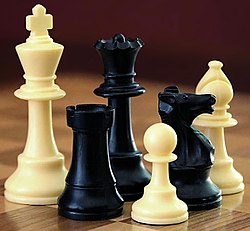
May 16, 2018
By Dr. Destin, Contributor
ach O’Brien ‘18 vs. Kaitlyn Hardesty ‘18
CCDS Championship Match 2018 | Cincinnati Country Day School | 10 May 2018 | 1-0
Figure 1.
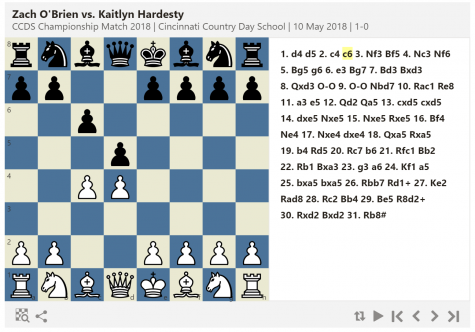
- d4 d5 2. c4 c6
Zach opened the game with the QUEEN’S GAMBIT—one of the oldest known chess openings—with the usual line of 1. d4 followed by 2. c4 when his d4 pawn is met with 1 …d5. (See Figure 1). The logic here (as with any gambit opening for that matter) is that Zach was willing to sacrifice a pawn with the hope of achieving an advantageous position. However, Kaitlyn didn’t take the bait. She decided not to capture the unprotected c4 pawn, which signaled that she was aware of her opponent’s plan (if she played 2 …dxc4 that would indicate that Kaitlyn accepted the Queen’s Gambit. Then Zach might have played 3. e4 thereby establishing the model position with two pawns on the central squares d4 and e4—hence achieving an advantageous position). Such a position would have yielded a winning percentage of 43.7% for white and 20.9% for black, and a draw percentage of 35.4% out of 1,803 games of similar positions according to the chessgames.com database).
Kaitlyn seemed to know this much, and so decided to decline the Queen’s Gambit, opting to move 2 …c6, and employing the SLAV DEFENSE, which is one of the primary defenses of the Queen’s Gambit. Kaitlyn’s decision to go Slavic on Zach recalls the pioneer of the Slav Defense, Russian and French chess player Alexander Alekhine (1892-1946), the fourth World Chess Champion. Excellent choice Kaitlyn!
Figure 2.
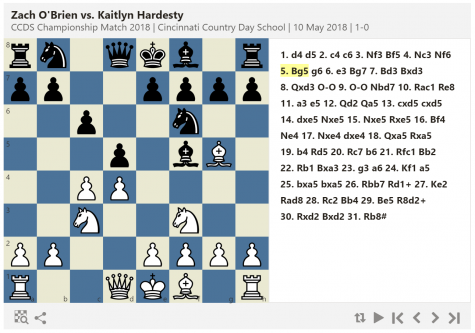
- Nf3 Bf5 4. Nc3 Nf6 5. Bg5
At this point of the game, Zach and Kaitlyn reached a position only about a dozen players have reached in the history of recorded chess games. (See Figure 2). According to the database of chessgames.com, as of today, only 11 games have reached a similar position, among them games played in high profile matches such as the 37th Chess Olympiad: Women (2006) tournament between Poornima Menon Jayadev and Frentina Andrea; the Politiken Cup (2015) tournament between Julius Molvig and Mads Wollan Myhre; and the World Blitz Championship (2017) tournament between Zeyad Saleh Al Abdali and Mohammed Alanazy.[1] White was the victor in eight of the eleven games. The three remaining games were a loss and two draws. So according to these statistics, by the 5th move, Zach was already favored to win the game. Zach, you are in great form! Great job!
However, Kaitlyn broke away from the Slav Defense with move 5 …g6 instead of the more promising move of 5 …e6, a move that helped 16-year old Norwegian Mads Wollan Myhre defeat Julius Molvig in the Politiken Cup match. Kaitlyn’s g6 move indicated her concern for king safety; she wanted to castle immediately, a chess move in which a player moves the king two squares towards a rook on the player’s first rank on the board, then moves the rook to the square over which the king crossed.[2]
Figure 3.
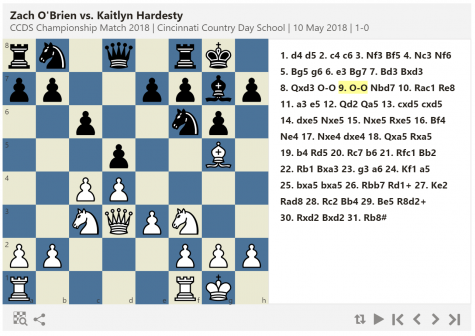
- e3 Bg7 7. Bd3 Bxd3 8. Qxd3 O-O 9. O-O
After a series of moves, both Zach and Kaitlyn succeeded in securing king safety, one of the primary objectives in the opening stage of the game. Another objective in chess is to get one’s minor pieces (knights and bishops) into play. Afterwards, the major pieces (queen and rooks) can be brought into play. Having some pawn development in the center of the board and minor and major pieces active is essential for engaging the next stage of the game: the middle game.
As we can see, Zach was fully developed to begin the middle game—he had some control of the center, knights are posted in squares for optimal attacks, a dark square bishop has some mobility, a queen can serve as a white square bishop, and his king was safe. Kaitlyn’s position, on the other hand, was slightly underdeveloped—she had yet to mobilize her queenside knight that could move in front of the queen. Then she would have to determine where to place her queen to give her rooks the ability to move freely left and right like Zach’s set of rooks. (See Figure 3). So, in terms of development, Kaitlyn was probably two moves behind Zach, who at this point had a little more momentum.
9 …Nbd7 10. Rac1 Re8 11. a3 e5
After a single exchange of minor pieces of equal value on move 7 …Bxd3 8. Qxd3 Kaitlyn began her attack! However, Zach held back with 12. Qd2
Figure 4.

12 …Qa5 13. cxd5 cxd5 14. dxe5 Nxe5 15. Nxe5 Rxe5 16. Bf4 Ne4(!?)
Here, Kaitlyn pulled a creative move, something one could see on a daily chess puzzle on chess.com. At first glance, it seemed Kaitlyn had put two of her pieces in harm’s way—her rook on e5 attacked by Zach’s bishop and her knight on e4 attacked by his knight. (See Figure 4). Upon further analysis, Kaitlyn figured out a way to simultaneously open her dark square bishop with her knight move on e4 AND attack the queen with the same knight to create an interesting play. If Zach was not careful, then his capture of the rook by his bishop on g5 could have cost him his queen, NxQd2!
Figure 5.
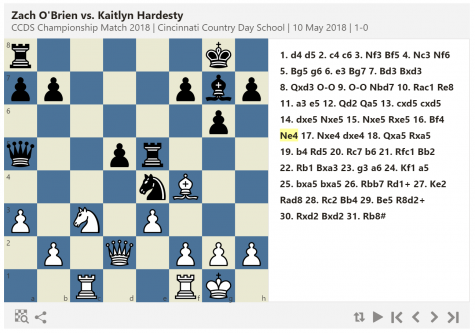
- Nxe4 dxe4 18. Qxa5 Rxa5
But Zach was not rattled by the position as demonstrated by his 17. Nxe4 play. However, after 18 …Rxa5, I think Kaitlyn was in a slightly better position. Her bishop threatened to take the b2 pawn, which meant Zach will need to defend it in some way so as not to fall behind in material. (See Figure 5). Up until this point, Kaitlyn and Zach had an equal value of points on the board. The chess point value system is as follows for each piece: a pawn is worth 1 point, a knight is 3 points, a bishop is roughly 3 points, a rook is 5 points, a queen is 9 points, and the king is worth the game. So, you can do the numbers: both Zach and Kaitlyn respectively had a total of 31 points on the board. However, to defend the pawn Zach would have to move the rook to b1, which would take it off the c-file; this would weaken his control of the game. Otherwise, he could move the rook to c2. Keeping his control of the c-file, however, would unfortunately allow Kaitlyn to bring her rook on a8 into play (possibly controlling the d-file after 19. Rc2 Rd8), giving her some momentum.
- b4(?)
Zach made a mistake! Kaitlyn could move 19 …Rxa3, which would decrease Zach’s point value by 1, giving her 19 points to Zach’s 18 points on the board. It seems Zach tried to defend the threatened b2 pawn by moving it up without realizing the a3 pawn would become undefended. Fortunately for him, Kaitlyn didn’t capitalize on the mistake…or did she?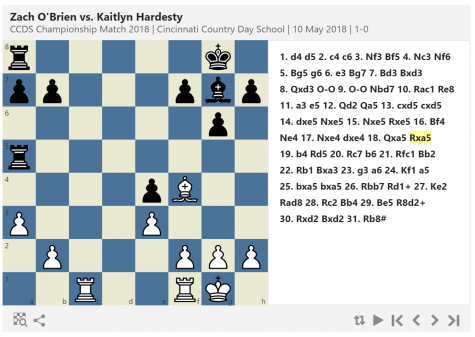
19 …Rd5 20. Rc7
Zach pounced at the chance of attacking the b7 pawn in hopes of doubling up the rooks on the c-file, which he eventually did with 21. Rfc1.
20 …b6 21. Rfc1 Bb2 22. Rb1 Bxa3 23. g3 a6 24. Kf1 a5 25. bxa5 bxa5 26. Rbb7 Rd1+ 27. Ke2 Rad8
The moment of truth. Kaitlyn controlled the entire middle game and now has the upper hand . She now threatened checkmate with R8d2# as they enter the endgame, the final stage of the game. Zach, realizing mate was at hand, retreated to 28. Rc2
Figure 6.
28 …Bb4 29. Be5(??)
Zach blundered with the Be5 move! Kaitlyn had mate in one with 29 …Re1#, but will she see it? (See Figure 6). It seems Zach was preoccupied with setting up checkmate with a dark square bishop on e5 with a possible rook play to c8 in black’s back-rank. With the chess clock ticking down to less than a minute, people in the audience were dying to know the outcome. Would Zach become our first Chess Master of Country Day, or would Kaitlyn with two losses in this best out of five match advance the championship game to round 4 for a possible comeback?
It seems the chess clock got the best of Kaitlyn. She missed the mate, deciding to check Zach’s king with 29 …R8d2+(?)
Zach followed with 30. Rxd2 Kaitlyn hastily moved 30 …Bxd2(??) allowing Zach to checkmate her king 31. Rb8#. (See Figure 7).
Figure 7.
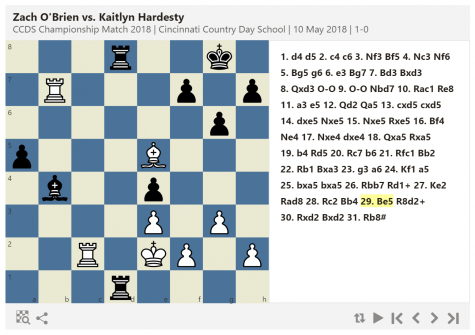
The room erupted with applause! Zach O’Brien ’18 was now the first Chess Master of Country Day!!! What a great match between Zach and Kaitlyn Hardesty ‘18! This was truly a match against the top two players of the tournament in a field of 20 players!
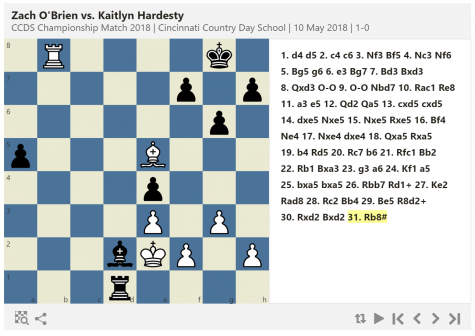
Wow. And what a nail biter ending. Zach was favored to win statistically with a strong chess opening, the Queen’s Gambit declined, an opening that has grown more popular after it was further theorized by Austrian and later American chess player Wilhelm Steinitz (1836-1900) and the first and undisputed World Chess Champion and Prussian chess player Siegbert Tarrasch (1862-1934), who was one of the strongest chess players and most influential chess teachers of the late 19th and early 20th century.
Zach had slightly more developed pawns and pieces than Kaitlyn in the opening game. However, Kaitlyn nicely recovered with a couple of interesting plays that allowed her to control the middle game. Her efforts put her in a position to win the game to advance to the next round—but ultimately to no avail. Zach’s move 29. Be5, appeared to be a blunder, but in the endgame, it positioned him to mate Kaitlyn with the rook.
Please congratulate our players!
If the reader would like to review the championship game, copy the PGN script below and paste it in any PGN viewer app.
[Event “CCDS Championship Match 2018”]
[Site “Cincinnati Country Day School”]
[Date “2018.05.10”]
[Round “?”]
[White “Zach O’Brien”]
[Black “Kaitlyn Hardesty”]
[Result “1-0”]
[WhiteElo “”]
[BlackElo “”]
[ECO “”]
[CurrentPosition “1R4k1/5p1p/6p1/p3B3/4p3/4P1P1/3bKP1P/3r4 b – – 1 31”]
- d4 d5 2. c4 c6 3. Nf3 Bf5 4. Nc3 Nf6 5. Bg5 g6 6. e3 Bg7 7. Bd3 Bxd3 8. Qxd3 O-O 9. O-O Nbd7 10. Rac1 Re8 11. a3 e5 12.
Qd2 Qa5 13. cxd5 cxd5 14. dxe5 Nxe5 15. Nxe5 Rxe5 16. Bf4 Ne4 17. Nxe4 dxe4 18. Qxa5 Rxa5 19. b4 Rd5 20. Rc7 b6 21. Rfc1
Bb2 22. Rb1 Bxa3 23. g3 a6 24. Kf1 a5 25. bxa5 bxa5 26. Rbb7 Rd1+ 27. Ke2 Rad8 28. Rc2 Bb4 29. Be5 R8d2+ 30. Rxd2 Bxd2 31.
Rb8# 1-0
REFERENCES TO QUEENS GAMBIT DECLINED SLAV
Jayadev—Frentina, 37th Chess Olympiad: Women. 2015, http://www.chessgames.com/perl/chessgame?gid=1416613
Molvig—Myhre, Politiken Cup. 2015, http://www.chessgames.com/perl/chessgame?gid=1796836
al-Abdali—Alanazy, World Blitz Champion. 2017, http://www.chessgames.com/perl/chessgame?gid=1906389
[1] Jayadev—Frentina, 37th Chess Olympiad: Women. 2015, http://www.chessgames.com/perl/chessgame?gid=1416613 ; Molvig—Myhre, Politiken Cup. 2015, http://www.chessgames.com/perl/chessgame?gid=1796836; al-Abdali—Alanazy, World Blitz Champion. 2017, http://www.chessgames.com/perl/chessgame?gid=1906389
[2] To learn more about castling: https://www.chess.com/chessopedia/view/castlin












